Pleistocene Paleoart of Australia
Abstract
:1. Introduction
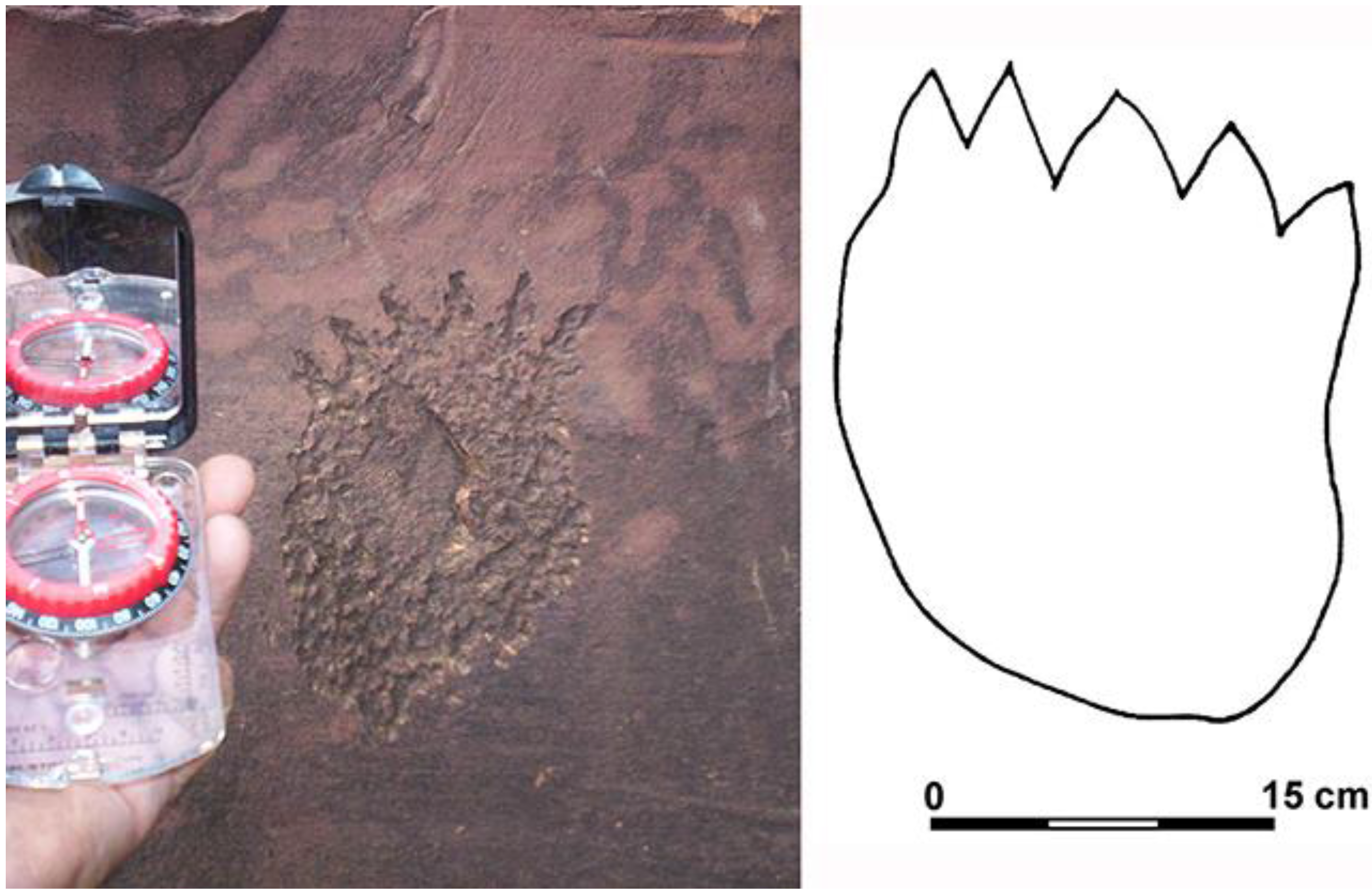

2. Misconceptions
Trendall’s view [relating to dolerite from Depuch Island], that it takes one million years, seems a little extreme in these circumstances (1964: 88) [96]. In a similar situation in the Negev Desert, Iron Age engravings which are approximately 2,500 years old have not repatinated to match the surrounding rock (Edwards 1971: 361).[48]
In this region we know of no engraved surface from Style IV-B (Iron Age) to Style VII (recent) with a patination identical to that of the original rock surface. This seems to mean that in this area it took a minimum of 2,500 years to reach an “0” shade, the natural color of the patina on the surface of the rock (Anati 1963: 189).[1]
no engravings have re-weathered to match the natural dark rock surface. As some of them are associated with the Iron Age, Anati believes it takes a minimum of 2,500 years for a thin, initial surface patination to form in the region (Edwards 1971: 361).[48]
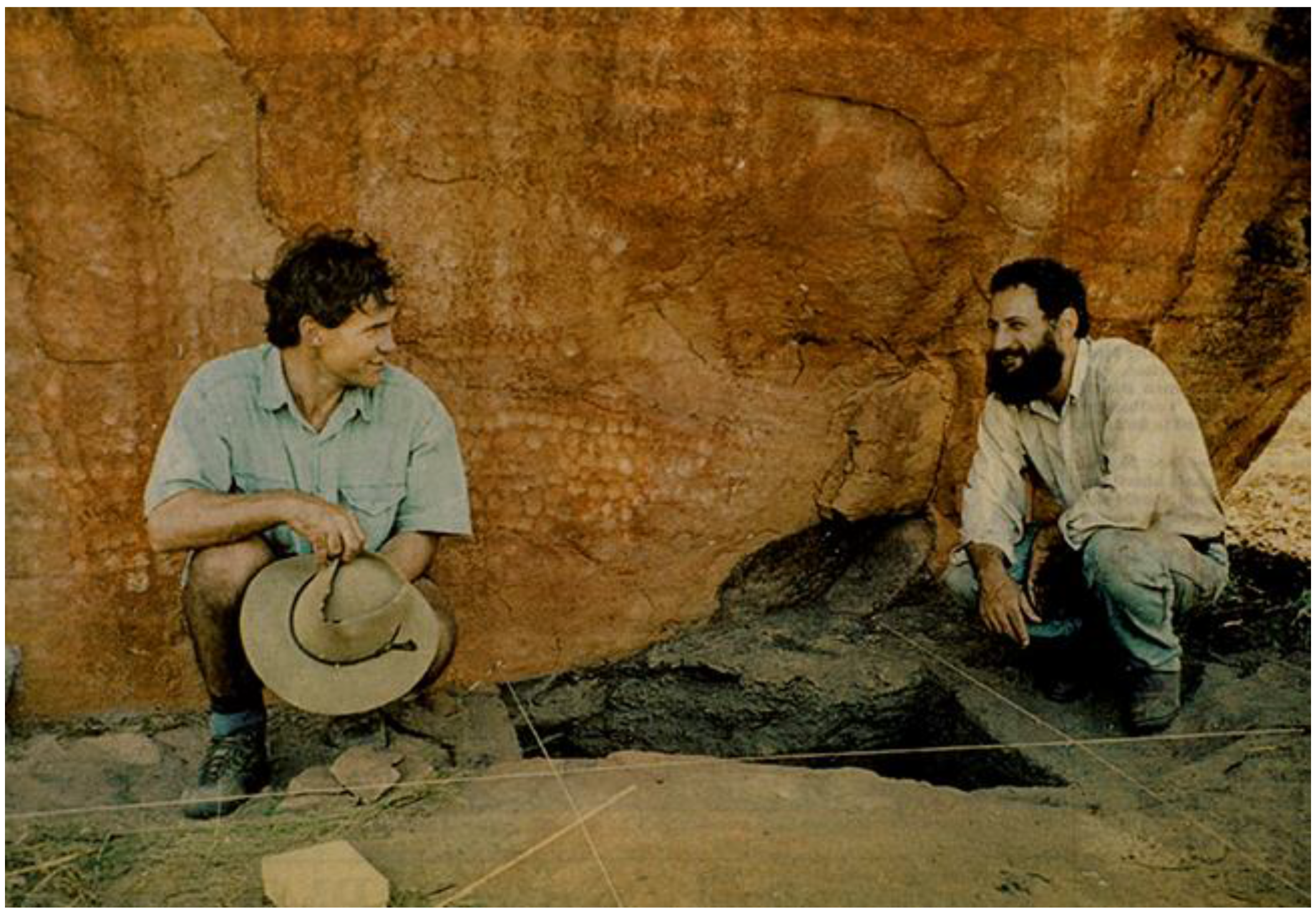
3. Pleistocene Petroglyphs in Australia

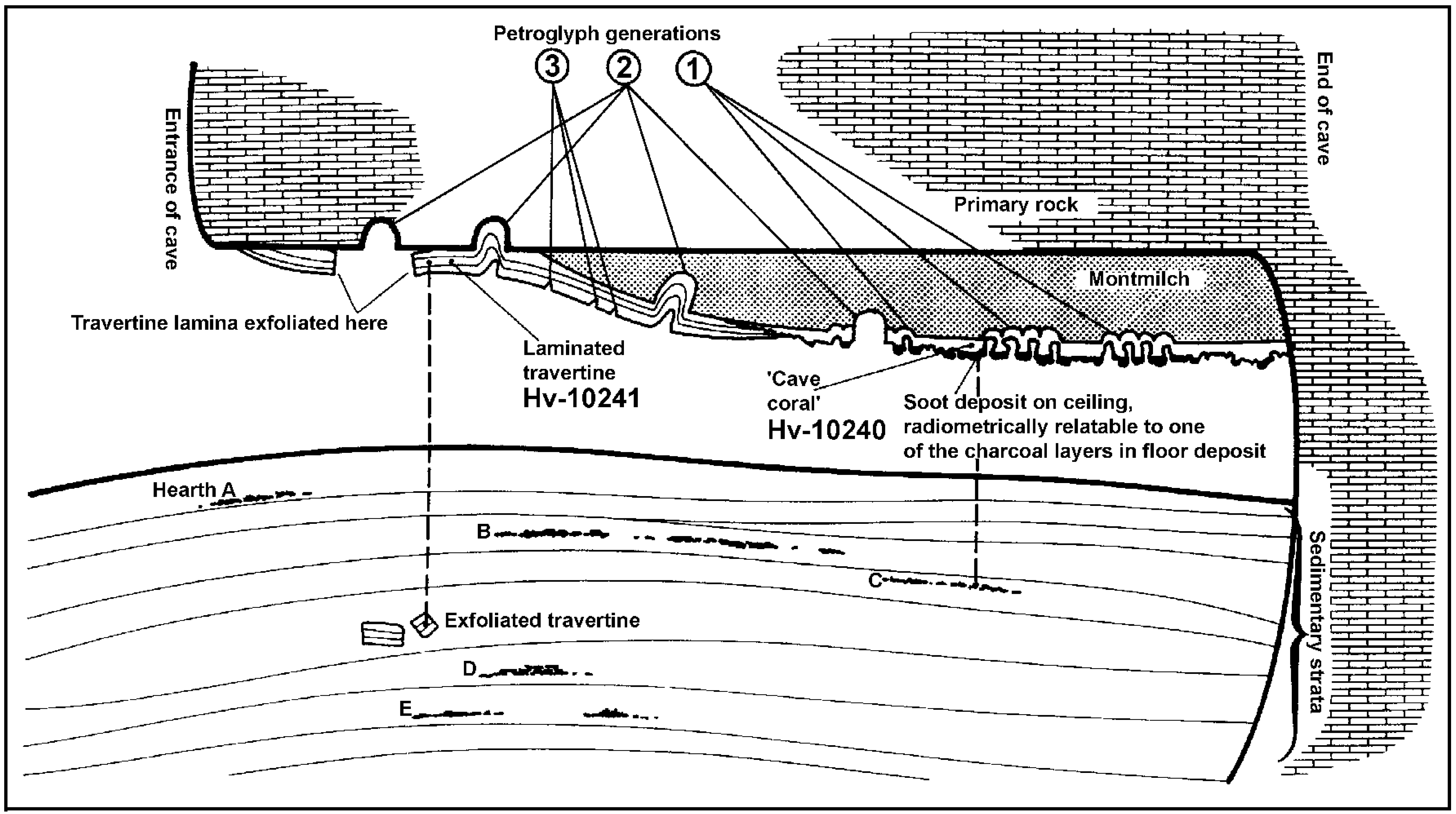
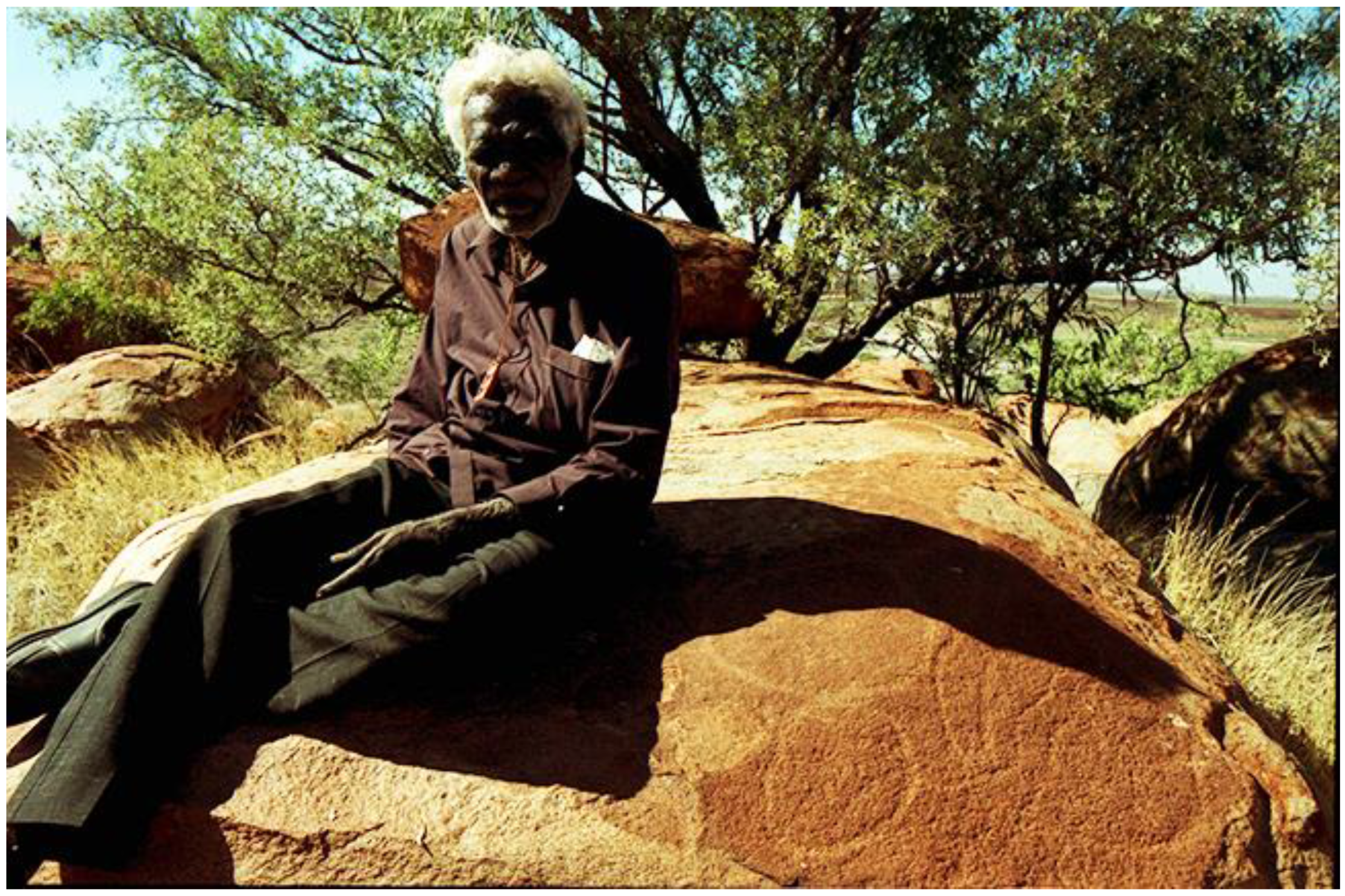
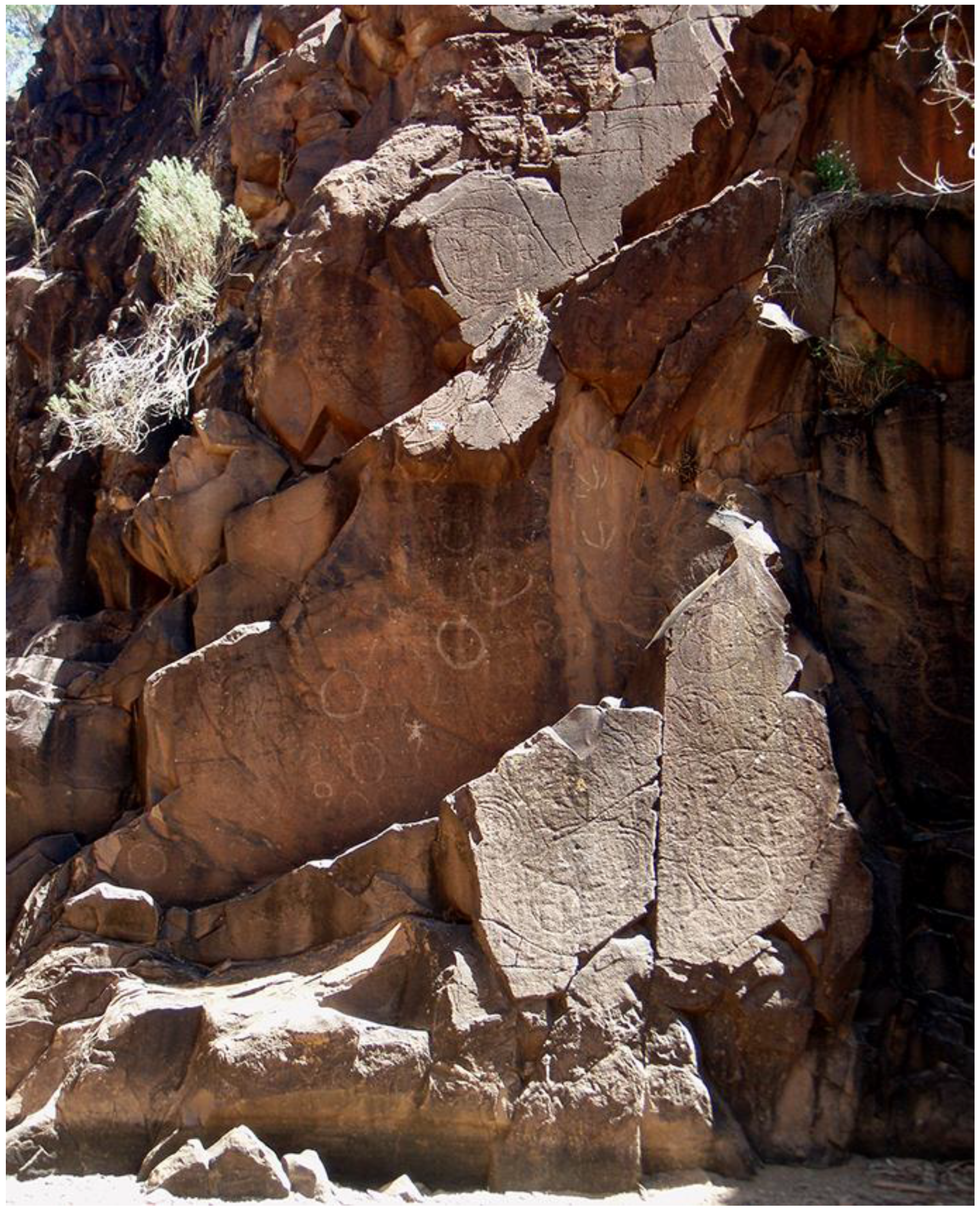
4. Pictograms and Portable Paleoart
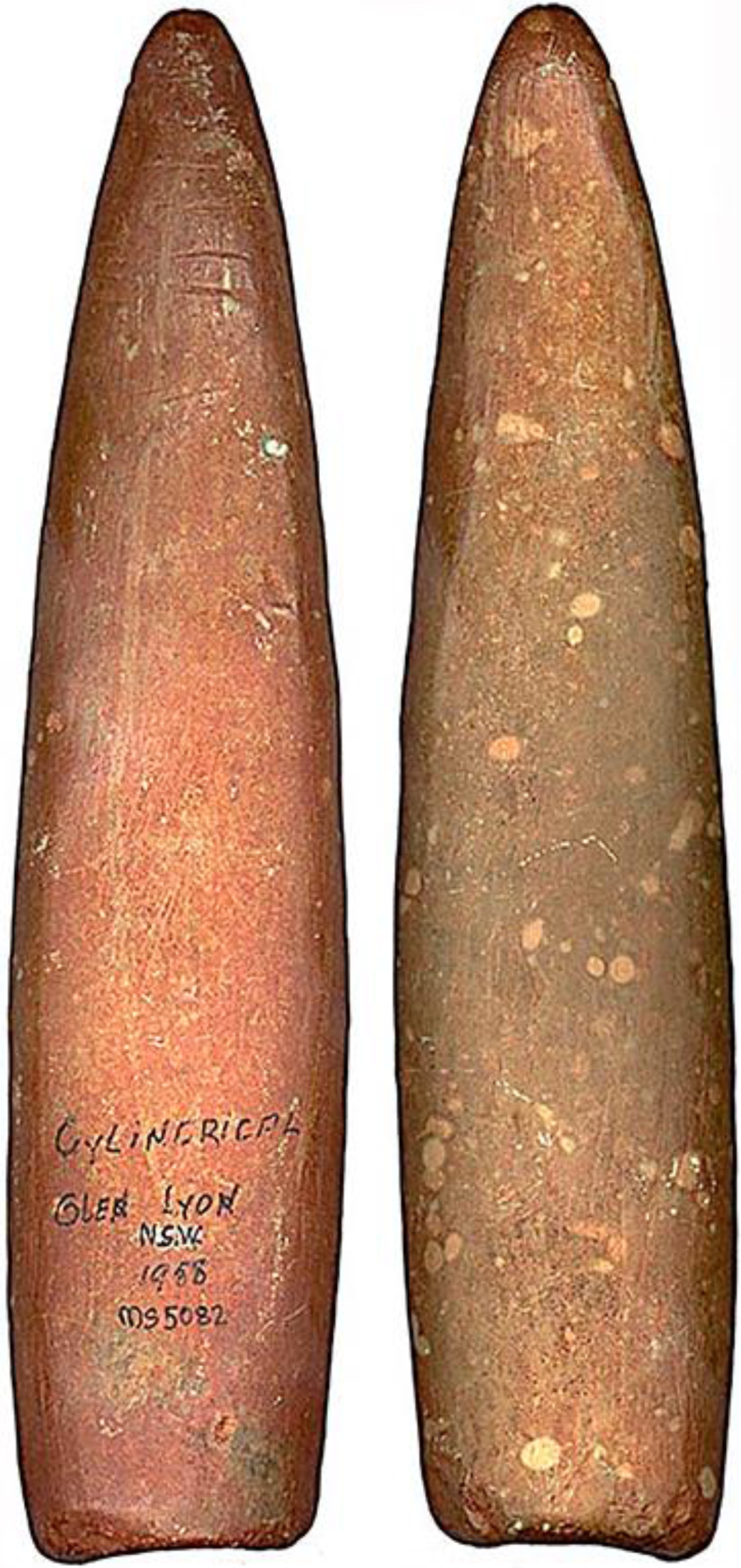
5. Discussion
- The number of Pleistocene rock art motifs of Australia massively exceeds that of Europe.
- All of those in Australia are of Mode 3 traditions and are non-figurative, whereas nearly all of those in Europe (with one exception, La Ferrassie) are thought to be of Mode 4 traditions (i.e., of the Upper Paleolithic, although this is now debatable).
Conflicts of Interest
References
- E. Anati. Palestine before the Hebrews. New York, NY, USA: Alfred A. Knopf, 1963. [Google Scholar]
- M. Aubert. “A review of rock art dating in the Kimberley, Western Australia.” J. Archaeol. Sci. 39 (2012): 573–577. [Google Scholar] [CrossRef]
- H. Basedow. “Aboriginal rock carvings of great antiquity in S.A.” J. R. Anthropol. Inst. 44 (1914): 195–211. [Google Scholar]
- W. Beck, D.J. Donahue, A.J.T. Jull, G. Burr, W.S. Broecker, G. Bonani, I. Hajdas, and E. Malotki. “Ambiguities in direct dating of rock surfaces using radiocarbon measurements.” Science 280 (1998): 2132–2135. [Google Scholar] [CrossRef]
- R.G. Bednarik. “The potential of rock patination analysis in Australian archaeology—Part 1.” Artefact 4 (1979): 14–38. [Google Scholar]
- R.G. Bednarik. “Die Bedeutung der paläolithischen Fingerlinientradition.” Anthropologie 23 (1984): 73–79. [Google Scholar]
- R.G. Bednarik. “Perspectives of Koongine Cave and scientistic archaeology.” Aust. Archaeol. 29 (1989): 9–16. [Google Scholar]
- R.G. Bednarik. “The cave petroglyphs of Australia.” Aust. Aborig. Stud. 2 (1990): 64–68. [Google Scholar]
- R.G. Bednarik. “On natural cave markings.” Helictite 29 (1991): 27–41. [Google Scholar]
- R.G. Bednarik. “Karst in siliceous rocks: The speleothem medium of finger flutings and its isotopic geochemistry.” Int. J. Speleol. 24 (1995): 55–66. [Google Scholar] [CrossRef]
- R.G. Bednarik. “Only time will tell: A review of the methodology of direct rock art dating.” Archaeometry 38 (1996): 1–13. [Google Scholar] [CrossRef]
- R.G. Bednarik. “Pleistocene stone pendant from Western Australia.” Aust. Archaeol. 45 (1997): 32–34. [Google Scholar]
- R.G. Bednarik. “Microscopic analysis of ‘engraved plaques’ and other objects from Devil’s Lair.” J. R. Soc. West. Aust. 81 (1998): 165–175. [Google Scholar]
- R.G. Bednarik. “The speleothem medium of finger flutings and its isotopic geochemistry.” Artefact 22 (1999): 49–64. [Google Scholar]
- R.G. Bednarik. “Pleistocene Timor: Some corrections.” Aust. Archaeol. 51 (2000): 16–20. [Google Scholar]
- R.G. Bednarik. “The dating of rock art: A critique.” J. Archaeol. Sci. 29 (2002a): 1213–1233. [Google Scholar] [CrossRef]
- R.G. Bednarik. “About the age of Pilbara rock art.” Anthropos 97 (2002b): 1–15. [Google Scholar]
- R.G. Bednarik. “The science of Dampier rock art—Part 1.” Rock Art Res. 24 (2007): 209–246. [Google Scholar]
- R.G. Bednarik. “The mythical Moderns.” J. World Prehist. 21 (2008): 85–102. [Google Scholar] [CrossRef]
- R.G. Bednarik. “Experimental colorimetric analysis of petroglyphs.” Rock Art Res. 26 (2009): 55–64. [Google Scholar]
- R.G. Bednarik. “Australian rock art of the Pleistocene.” Rock Art Res. 27 (2010): 95–120. [Google Scholar]
- R.G. Bednarik. “Megafauna depictions in Australian rock art.” Rock Art Res. 30 (2013a): 197–215. [Google Scholar]
- R.G. Bednarik. “Pleistocene palaeoart of Africa. Special issue ‘World rock art’, ed. R.G. Bednarik.” Arts 2 (2013b): 6–34. Available online: https://www.mdpi.com/2076-0752/2/1/6. [Google Scholar]
- R.G. Bednarik. “Pleistocene palaeoart of Asia. Special issue ‘World rock art’, ed. R.G. Bednarik.” Arts 2 (2013c): 46–76. Available online: https://www.mdpi.com/2076-0752/2/2/46. [Google Scholar]
- R.G. Bednarik. “Mud-wasp nests and rock art.” Rock Art Res. 31 in press. (2014). [Google Scholar]
- R.M. Berndt. “Panaramitee magic.” Rec. South Aust. Mus. 20 (1987): 15–28. [Google Scholar]
- L. Black. Cylcons: The Mystery Stones of the Darling River Valley. Leeton, N.S.W.: Lindsay Black. p. 1942.
- J. Černohouz, and I. Solč. “Use of sandstone wanes and weathered basaltic crust in absolute chronology.” Nature 212 (1966): 806–807. [Google Scholar] [CrossRef]
- J. Clarke. Rock Patination and the Age of Aboriginal Engravings at Dampier. Perth, Australia: W.A. Unpubl. Report to the Department of Aboriginal Sites, Western Australian Museum, 1978. [Google Scholar]
- N. Cole, and A. Watchman. “AMS dating of rock art in the Laura region, Cape York Peninsula, Australia—Protocols and results of recent research.” Antiquity 79 (2005): 661–678. [Google Scholar]
- I.M. Crawford. “The engravings of Depuch Island.” In Report on the Aboriginal Engravings and Flora and Fauna, Depuch Island, Western Australia. Edited by W.D.L. Ride and A. Neumann. Perth, Australia: Western Australian Museum Special Publication 2, 1964, pp. 23–63. [Google Scholar]
- R.I. Dorn. “Cation-ratio dating: A new rock varnish age-determination technique.” Quat. Res. 20 (1983): 49–73. [Google Scholar] [CrossRef]
- R.I. Dorn. “Rock varnish as an indicator of aeolian environmental change.” In Aeolian Geo-Morphology. Edited by W.G. Nickling. London, UK: Allen and Unwin, 1986, pp. 291–307. [Google Scholar]
- R.I. Dorn. “Rock varnish dating of rock art: State of the art perspective.” La Pint. 17 (1990): 9–11. [Google Scholar]
- R.I. Dorn. “A review of rock varnish dating of rock engravings.” Int. Newsl. Rock Art 2 (1992): 10–14. [Google Scholar]
- R.I. Dorn. “Dating petroglyphs with a three-tier rock varnish approach.” In New Light on Old Art. Edited by D.S. Whitley and L.L. Loendorf. Los Angeles, CA, USA: Institute of Archaeology, University of California, 1994, pp. 13–36, Monograph 36. [Google Scholar]
- R.I. Dorn. “A change of perception.” La Pint. 23 (1996a): 10–11. [Google Scholar]
- R.I. Dorn. “Uncertainties in 14C ages for petroglyphs from the Olary province, South Australia.” Archaeol. Ocean. 31 (1996b): 214–215. [Google Scholar]
- R.I. Dorn. “Constraining the age of the Côa valley (Portugal) engravings with radiocarbon dating.” Antiquity 71 (1997): 105–115. [Google Scholar]
- R.I. Dorn, P.B. Clarkson, M.F. Nobbs, L.L. Loendorf, and D.S. Whitley. “New approach to the radiocarbon dating of rock varnish, with examples from drylands.” Ann. Assoc. Am. Geogr. 82 (1992): 136–151. [Google Scholar] [CrossRef]
- R.I. Dorn, and D.S. Whitley. “Chronometric and relative age determination of petroglyphs in the western United States.” Ann. Assoc. Am. Geogr. 42 (1984): 308–322. [Google Scholar] [CrossRef]
- C.E. Dortch. “Two engraved stone plaques of late Pleistocene age from Devil’s Lair, Western Australia.” Archaeol. Phys. Anthropol. Ocean. 11 (1976): 32–44. [Google Scholar]
- C.E. Dortch. Devil’s Lair, a study in prehistory. Perth: Western Australian Museum.
- D. Dragovich. “1984a. Desert varnish as an age indicator for Aboriginal rock engravings: A review of problems and prospects.” Archaeol. Ocean. 19 (1984): 48–56. [Google Scholar] [CrossRef]
- D. Dragovich. “Minimum age for desert varnish in the Broken Hill area, N.S.W.: A preliminary estimate.” Search 15 (1984b): 113–115. [Google Scholar]
- D. Dragovich. “Minimum age of some desert varnish near Broken Hill, News South Wales.” Search 17 (1986): 149–151. [Google Scholar]
- R. Edwards. “Rock engravings and incised stones: Tiverton Station, north-east South Australia.” Mankind 6 (1965): 223–231. [Google Scholar] [CrossRef]
- R. Edwards. “Art and Aboriginal prehistory.” In Aboriginal Man and Environment in Australia. Edited by D.J. Mulvaney and J. Golson. Canberra, Australia: Australian National University Press, 1971, pp. 356–367. [Google Scholar]
- R. Ethridge. “The cylindro-conical and stone implements of western New South Wales and their significance.” In Memoirs of the Geological Survey of New South Wales. Ethnological Series 2; 1916, pp. 1–41. Sydney, Australia: Publisher unknown. [Google Scholar]
- D. Frankel. “Excavations in the lower southeast of South Australia: November 1985.” Aust. Archaeol. 22 (1986): 75–87. [Google Scholar]
- R.L.K. Fullagar, D.M. Price, and L.M. Head. “Early human occupation of northern Australia: Archaeology and thermoluminescence dating of Jinmium rock-shelter, Northern Territory.” Antiquity 70 (1996): 751–773. [Google Scholar]
- A. Gallus. “Parietal art in Koonalda Cave, Nullarbor Plain, South Australia.” Helictite 6 (1968): 43–49. [Google Scholar]
- A. Gallus. “Results of the exploration of Koonalda Cave, 1956–1968.” In Archaeology of the Gallus Site, Koonalda Cave. Edited by R.V.S. Wright. Canberra, Australia: Australian Institute of Aboriginal Studies, 1971, pp. 87–133. [Google Scholar]
- A. Gallus. “Comment on R.G. Bednarik, ‘Parietal finger markings in Europe and Australia’.” Rock Art Res. 3 (1986): 56–59. [Google Scholar]
- A. Gibbons. “Doubts over spectacular dates.” Science 278 (1997): 220–222. [Google Scholar] [CrossRef]
- R. Gillespie. “On human blood, rock art and calcium oxalate: Further studies on organic carbon content and radiocarbon age of materials relating to Australian rock art.” Antiquity 71 (1997): 430–437. [Google Scholar]
- M.M. Hale, and N.B. Tindale. “Notes on some human remains in the lower Murray valley, South Australia.” Rec. South Aust. Mus. 4 (1930): 145–218. [Google Scholar]
- S.J. Hallam. “Roof markings in the ‘Orchestra Shell’ Cave, Wanneroo, near Perth, Western Australia.” Mankind 8 (1971): 90–103. [Google Scholar]
- B.U. Haq, J. Hardenbol, and P.R. Vail. “Chronology of fluctuating sea levels since the Triassic (250 million years ago to present).” Science 235 (1987): 1156–1167. [Google Scholar] [CrossRef] [PubMed]
- Archaeological Research in Kakadu National Park. R. Jones, ed. Canberra, Australia: Australian National Parks and Wildlife Service, 1985.
- M. Lorblanchet. “The rock engravings of Gum Tree Valley and Skew Valley, Dampier, Western Australia: Chronology and function of the sites.” In State of the Art: Regional Rock Art Studies in Australia and Melanesia. Edited by J. McDonald and I.P. Haskovec. Melbourne, Australia: Occasional AURA Publication 6, Australian Rock Art Res. Association, 1992, pp. 39–59. [Google Scholar]
- H. Lourandos. Continent of Hunter-Gatherers. Cambridge, UK: Cambridge University Press, 1997. [Google Scholar]
- T.H. Loy. “Direct dating of rock art at Laurie Creek (NT), Australia: A reply to Nelson.” Antiquity 68 (1994): 147–148. [Google Scholar]
- T.H. Loy, R. Jones, D.E. Nelson, B. Meehan, J. Vogel, J. Southon, and R. Cosgrove. “Accelerator radiocarbon dating of human blood proteins in pigments from Late Pleistocene art sites in Australia.” Antiquity 64 (1990): 110–116. [Google Scholar]
- N.W.G. Macintosh. “Paintings in Beswick Creek Cave, Northern Territory.” Oceania 22 (1952): 256–274. [Google Scholar] [CrossRef]
- N.W.G. Macintosh. “Beswick Creek Cave two decades later: A reappraisal.” In Form in Indigenous Art. Edited by P.J. Ucko. Canberra, Australia: Australian Institute of Aboriginal Studies, 1977, pp. 191–197. [Google Scholar]
- F.D. McCarthy. Australian Aboriginal Stone Implements. Sydney, Australia: V.C.N. Blight, 1967. [Google Scholar]
- J. McDonald, K. Officer, T. Jull, D. Donahue, J. Head, and B. Ford. “Investigating 14C AMS: Dating prehistoric rock art in the Sydney Sandstone Basin, Australia.” Rock Art Res. 7 (1990): 83–92. [Google Scholar]
- L. Maynard. “The archaeology of Australian Aboriginal art.” In Exploring the Visual Art of Oceania. Edited by S.M. Mead. Honolulu, HI, USA: University of Hawaii, 1979, pp. 83–110. [Google Scholar]
- K.G. Miller, G.S. Mountain, J.V. Browning, M. Kominz, P.J. Sugarman, N. Christie-Blick, M.E. Katz, and J.D. Wright. “Cenozoic global sea level, sequences, and the New Jersey transect: Results from coastal plain and continental slope drilling.” Rev. Geophys. 36 (1998): 569–601. [Google Scholar] [CrossRef]
- K. Morse. “Shell beads from Mandu Mandu creek rock-shelter, Cape Range Peninsula, Western Australia, dated before 30,000 bp.” Antiquity 67 (1993): 877–883. [Google Scholar]
- M. Morwood. “Archaeology of the Central Queensland Highlands: The stone component.” Archaeol. Ocean. 16 (1981): 1–52. [Google Scholar] [CrossRef]
- C.P. Mountford. “A unique example of Aboriginal rock engraving at Panaramitee North.” Trans. Proc. R. Soc. S. Aust. 53 (1929): 245–248. [Google Scholar]
- C.P. Mountford. Nomads of the Australian Desert. Adelaide, Australia: Rigby, 1976. [Google Scholar]
- C.P. Mountford, and R. Edwards. “Aboriginal rock engravings of extinct creatures in South Australia.” Man 62 (1962): 97–99. [Google Scholar] [CrossRef]
- C.P. Mountford, and R. Edwards. “Rock engravings of Panaramitee Station, South Australia.” Trans. Proc. R. Soc. S. Aust. 86 (1963): 131–146. [Google Scholar]
- D.J. Mulvaney. The Prehistory of Australia. Melbourne, Australia: Pelican, 1975. [Google Scholar]
- K.J. Mulvaney. “Murujuga Marni—Dampier petroglyphs: Shadows in the landscape echoes across time.” Ph.D. Thesis, University of New England, 2010. [Google Scholar]
- P.F. Murray, and G. Chaloupka. “The dreamtime animals: Extinct megafauna in Arnhem Land rock art.” Archaeol. Ocean. 19 (1984): 105–116. [Google Scholar] [CrossRef]
- D.E. Nelson. “Second thoughts on a rock-art date.” Antiquity 67 (1993): 893–895. [Google Scholar]
- M.F. Nobbs, and R.I. Dorn. “Age determinations for rock varnish formation within petroglyphs: Cation-ratio dating of 24 motifs from the Olary region, South Australia.” Rock Art Res. 5 (1988): 108–146. [Google Scholar]
- S. O’Connor. “Carpenter’s Gap Rockshelter 1: 40,000 years of Aboriginal occupation in the Napier Ranges, Kimberley, WA.” Aust. Archaeol. 40 (1995): 58–59. [Google Scholar]
- P. Ossa, B. Marshall, and C. Webb. “New Guinea II Cave: A Pleistocene site on the Snowy River, Victoria.” Archaeol. Ocean. 30 (1995): 22–35. [Google Scholar] [CrossRef]
- A. Roberts, and I. N. Franklin. “Campbell and the Mannum Aboriginal Community Association Inc. 2014. Ngaut Ngaut (Devon Downs) petroglyphs reconsidered.” Rock Art Res. 31 (2014): 36–46. [Google Scholar]
- R. Roberts, T. Flannery, L. Ayliffe, H. Yoshida, J. Olley, G. Prideaux, G. Laslett, A. Baynes, M. Smith, R. Jones, and et al. “New ages for the Australian mega fauna: Continent-wide extinction about 46,000 years ago.” Science 292 (2001): 1888–1892. [Google Scholar] [CrossRef] [PubMed]
- R.G. Roberts, R.F. Galbraith, J.M. Olley, H. Yoshida, and G.M. Laslett. “Optical dating of single and multiple grains of quartz from Jinmium rock shelter, northern Australia: Part II, results and implications.” Archaeometry 41 (1999): 365–395. [Google Scholar] [CrossRef]
- R.G. Roberts, R. Jones, and M.A. Smith. “Thermoluminescence dating of a 50,000-year-old human occupation site in northern Australia.” Nature 345 (1990): 153–156. [Google Scholar] [CrossRef]
- R.G. Roberts, R. Jones, and M.A. Smith. “Optical dating at Deaf Adder Gorge, Northern Territory, indicates human occupation between 53,000 and 60,000 years ago.” Aust. Archaeol. 37 (1993): 58–59. [Google Scholar]
- R. Roberts, G. Walsh, A. Murray, J. Olley, R. Jones, M. Morwood, C. Tuniz, E. Lawson, M. Macphail, D. Bowdery, and et al. “Luminescence dating of rock art and past environments using mud-wasp nests in northern Australia.” Nature 387 (1997): 696–699. [Google Scholar] [CrossRef]
- R.G. Roberts, M. Bird, J. Olley, R. Galbraith, E. Lawson, G. Laslett, H. Yoshida, R. Jones, R. Fullagar, G. Jacobsen, and et al. “Optical and radiocarbon dating at Jinmium rock shelter in northern Australia.” Nature 393 (1998): 358–362. [Google Scholar] [CrossRef]
- A. Rosenfeld. “Excavations at the Early Man Shelter.” In Early Man in North Queensland. Edited by A. Rosenfeld, D. Horton and J. Winter. Canberra, Australia: erra Australis 6, Department of Prehistory, Research School of Pacific Studies, Australian National University, 1981, pp. 5–34. [Google Scholar]
- N. Rothwell. “Politics etched in stone.” The Australian, 23 September 1996, 1 and 41 and 4. [Google Scholar]
- S. Rule, B.W. Brook, S.G. Haberle, C.S.M. Turney, A.P. Kershaw, and C.N. Johnson. “The aftermath of megafaunal extinction: Ecosystem transformation in Pleistocene Australia.” Science 335 (2012): 1483–1486. [Google Scholar] [CrossRef] [PubMed]
- A. Thorne, R. Grün, G. Mortimer, A.A. Spooner, J.J. Simpson, M. McCulloch, L. Taylor, and D. Curnoe. “Australia’s oldest human remains: Age of the Lake Mungo 3 skeleton.” J. Hum. Evol. 36 (1999): 591–612. [Google Scholar] [CrossRef] [PubMed]
- N.B. Tindale. “Comments on supposed representations of giant bird tracks at Pimba.” Rec. South Aust. Mus. 9 (1951): 381–382. [Google Scholar]
- A.F. Trendall. “Examination of rocks with Aboriginal engravings. Appendix.” In Depuch Island. Edited by W.D.L. Ride and A. Neumann. Perth, Australia: Western Australian Museum Special Publication 2, 1964, pp. 83–88. [Google Scholar]
- P. Trezise. Dream Road: A Journey of Discovery. Sydney, Australia: Allen & Unwin, 1993. [Google Scholar]
- N. Tuross, and I. Barnes. “Protein identification of blood residues on experimental stone tools.” J. Archaeol. Sci. 23 (1996): 289–296. [Google Scholar] [CrossRef]
- A. Watchman. “Investigating the cation-ratio calibration curve: Evidence from South Australia.” Rock Art Res. 9 (1992a): 106–110. [Google Scholar]
- A. Watchman. “Re-painting or periodic-painting at Australian Aboriginal sites: Evidence from rock surface crusts.” In Retouch: Maintenance and Conservation of Aboriginal Rock Imagery. Edited by G.K. Ward. Melbourne, Australia: Occasional AURA Publication 5, Archaeological Publications, 1992b, pp. 26–30. [Google Scholar]
- A. Watchman. “Evidence of a 25,000-year-old pictograph in northern Australia.” Geoarchaeology 8 (1993): 465–473. [Google Scholar] [CrossRef]
- A. Watchman. “A universal standard for reporting the ages of petroglyphs and rock paintings.” In Dating and the Earliest Known Rock Art. Edited by M. Strecker and P. Bahn. Oxford, UK: Oxbow Books, 1999, pp. 1–3. [Google Scholar]
- A. Watchman. “Micro-excavation and laser extraction methods for dating carbon in silica skins and oxalate crusts.” In Advances in Dating Australian Rock-Markings. Edited by G.K. Ward and C. Tuniz. Melbourne, Australia: Occasional AURA Publication 10, Australian Rock Art Res. Association Inc., 2000, pp. 35–39. [Google Scholar]
- A.L. Watchman, and E. Hatte. “A nano approach to the study of rock art: The Walkunders, Chillagoe, north Queensland, Australia.” Rock Art Res. 13 (1996): 85–92. [Google Scholar]
- A.L. Watchman, G.L. Walsh, M.J. Morwood, and C. Tuniz. “AMS radiocarbon age estimates for early rock paintings in the Kimberley, N.W. Australia: Preliminary results.” Rock Art Res. 14 (1997): 18–26. [Google Scholar]
© 2014 by the authors; licensee MDPI, Basel, Switzerland. This article is an open access article distributed under the terms and conditions of the Creative Commons Attribution license (http://creativecommons.org/licenses/by/3.0/).
Share and Cite
Bednarik, R.G. Pleistocene Paleoart of Australia. Arts 2014, 3, 156-174. https://doi.org/10.3390/arts3010156
Bednarik RG. Pleistocene Paleoart of Australia. Arts. 2014; 3(1):156-174. https://doi.org/10.3390/arts3010156
Chicago/Turabian StyleBednarik, Robert G. 2014. "Pleistocene Paleoart of Australia" Arts 3, no. 1: 156-174. https://doi.org/10.3390/arts3010156



